Structure. Octadecanoids belong to the fatty acyls. Their structure is based on octadecanoic acid, an eighteen carbon atoms long hydrocarbon chain with a carboxyl group. Octadecanoids, eicosanoids, docosanoids, and further lipid groups are collectively termed oxylipins. Their hydrocarbon chain features oxygen-containing substituents, they are oxidized fatty acyls. Often, octadecanoids contain one or more double bonds.
Function. Octadecanoids are found in eukaryotes such as animals, plants, and fungi, but rarely in prokaryotes. On a cellular level, octadecanoids are often present in free form or linked to complex lipids such as phospholipids to be released on demand. The composition of the hydrocarbon chain impacts their biological function to a high degree.
Oxidized octadecaenoic acids (oxiOME) are linked to modifying inflammatory responses and cellular reaction to cold temperature. While oxidized octadecadienoic acids (oxiODE) are also related to inflammation, they are vital in controlling the immune system as well. Further, oxidized octadecatrienoic acids (oxiOTrE) are involved in the regulation of oxidative stress and inflammation and possess inhibitory effects on blood platelet and anti-inflammatory properties.
